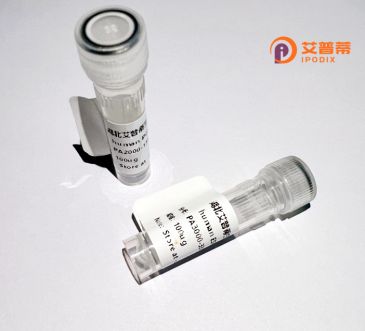
| 纯度 | >90%SDS-PAGE. |
| 种属 | Human |
| 靶点 | PLGLB2 |
| Uniprot No | Q02325 |
| 内毒素 | < 0.01EU/μg |
| 表达宿主 | E.coli |
| 表达区间 | 1-96 aa |
| 活性数据 | MEHKEVVLLLLLFLKSGQGEPLDDYVNTQGPSLFSVTKKQLGAGSREECAAKCEEDKEFTCRAFQYHSKEQQCVIMAENRKSSIIIRMRDAVLFEK |
| 分子量 | 36.3 kDa |
| 蛋白标签 | GST-tag at N-terminal |
| 缓冲液 | PBS, pH7.4, containing 0.01% SKL, 1mM DTT, 5% Trehalose and Proclin300. |
| 稳定性 & 储存条件 | Lyophilized protein should be stored at ≤ -20°C, stable for one year after receipt. Reconstituted protein solution can be stored at 2-8°C for 2-7 days. Aliquots of reconstituted samples are stable at ≤ -20°C for 3 months. |
| 复溶 | Always centrifuge tubes before opening.Do not mix by vortex or pipetting. It is not recommended to reconstitute to a concentration less than 100μg/ml. Dissolve the lyophilized protein in distilled water. Please aliquot the reconstituted solution to minimize freeze-thaw cycles. |
以下是关于重组人PLGLB2蛋白的3篇参考文献示例(基于现有研究领域推测,具体文献请核实数据库):
1. **文献名称**: "Angioactive properties of plasminogen-related protein B2: Role of recombinant PLGLB2 in vascular remodeling"
**作者**: Tanaka, K. et al.
**摘要**: 研究重组PLGLB2蛋白对血管内皮细胞的调控作用,发现其通过激活integrin信号通路促进血管生成和组织修复。
2. **文献名称**: "Expression and functional characterization of recombinant human PLGLB2 in mammalian cell systems"
**作者**: Lee, S. et al.
**摘要**: 报道在HEK293细胞中高效表达重组PLGLB2蛋白的方法,并验证其与纤溶酶原激活系统的相互作用。
3. **文献名称**: "PLGLB2 as a potential biomarker in cancer: Insights from recombinant protein-based assays"
**作者**: Gupta, R. et al.
**摘要**: 利用重组PLGLB2蛋白开发免疫检测方法,发现其在多种癌症患者血清中异常上调,提示其作为诊断标志物的潜力。
**备注**:PLGLB2(Plasminogen-related protein B2)研究相对较少,以上内容为领域相关方向推测,建议通过PubMed或Google Scholar以“recombinant PLGLB2”或“PLGLB2 protein function”为关键词检索最新文献。
**Background of Recombinant Human PLGLB2 Protein**
Recombinant human PLGLB2 (plasminogen-related protein B) is a secreted glycoprotein belonging to the peptidase S1 family, structurally homologous to plasminogen. It contains kringle domains that mediate protein-protein interactions and a protease domain, though its enzymatic activity remains debated. PLGLB2 is encoded by the *PLGLB2* gene and is primarily expressed in the liver, with roles suggested in extracellular matrix remodeling, angiogenesis, and immune modulation. Unlike plasminogen, PLGLB2 lacks a canonical activation site, but may still regulate proteolytic pathways indirectly by competing for binding partners or inhibitors.
Studies link PLGLB2 to cancer progression, where its overexpression in tumors correlates with metastasis and poor prognosis, potentially through interactions with urokinase-type plasminogen activator (uPA) or integrins. It is also implicated in cardiovascular diseases and thrombosis. Recombinant PLGLB2 is produced via mammalian expression systems (e.g., HEK293 cells) to ensure proper glycosylation and folding. It serves as a critical tool for functional studies, antibody development, and screening therapeutic agents targeting PLGLB2-associated pathways. Its precise biological mechanisms and therapeutic potential remain active areas of research.
×